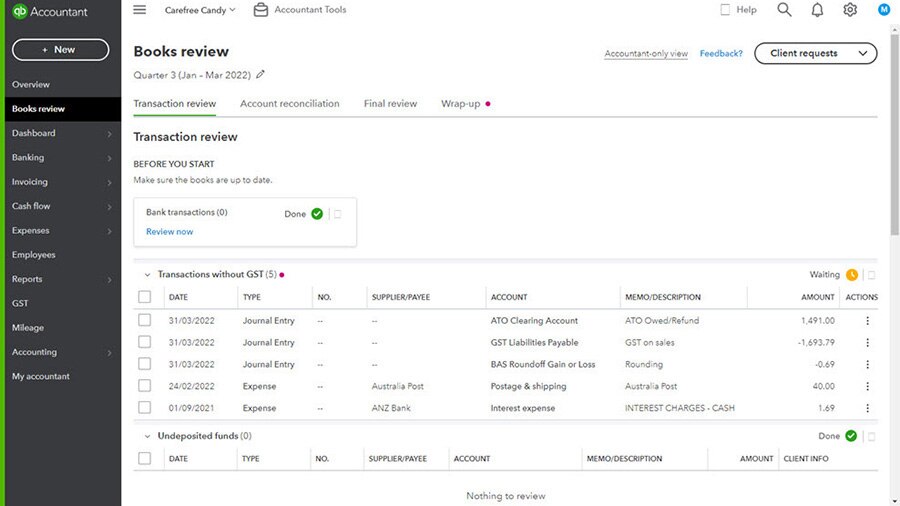Accounting formulas for businesses
Accounting formulas are used for many purposes, such as producing a statement of cash flows, reviewing inventory turnover, and analysing total sales. Here, we’ll unpack some of the most common equations businesses should know.
1. Accounting equation
The accounting equation or balance sheet equation is one of the most important formulas you should know. So, what is the accounting equation exactly?
The accounting equation is the foundation of double-entry bookkeeping. It must always balance.
Assets = Liabilities + Equity
Breakdown:
- Assets: Cash, inventory, equipment, receivables.
- Liabilities: Payables, loans, leases, accrued expenses.
- Equity: Owner/shareholder interest (capital + retained earnings).
If the left side (assets) doesn’t equal the right (liabilities + equity), there’s an error in your entries.
2. Net income equation
As a business owner, it’s important to know whether your company is profitable or not, especially if you’re looking for investors. One business formula that investors want to look at is the net income equation:
Net income = Revenue − Expenses
Breakdown:
- Revenue is the cash inflow that comes into your business (sales and other income).
- Expenses are the costs incurred to generate revenue (COGS, operating costs, interest, tax).
Ended up with a negative result? That indicates a net loss and you should investigate your pricing, costs or volume.
3. Break-even point equation
The accounting break-even formula tells you the sales you need to make $0 profit (and not lose money on production costs).
Break-even units = Fixed costs ÷ (Price per unit − Variable cost per unit)
Breakdown:
- Fixed costs: Rent, salaries, insurance, subscriptions.
- Price per unit: What you charge per unit.
- Variable cost per unit: Costs that move with volume (materials, shipping).
The break-even point tells you how much you need to sell to cover all of your costs. Every sale over the break-even point will generate a profit.
4. Cash ratio equation
Most businesses take on some form of credit to operate, such as business loans, mortgages, and pension obligations. The cash ratio equation measures your company’s liquidity, or ability to pay off all of these liabilities at once if you were required to do so.
Cash ratio = cash ÷ current liabilities
Breakdown:
- Cash and equivalents: Bank balances, very liquid investments.
- Current liabilities: Debts due within 12 months.
A higher cash ratio is safer, but too high may mean that you have idle cash that’s not being invested.
5. Profit margin equation
To get a better understanding of how your business uses its revenue to generate profits, use the profit margin equation to measure how efficiently your revenue becomes profit. Not only does this accounting formula show the overall health of your company, but it also helps you plan your next moves.
Profit margin = Net income ÷ Sales
Breakdown:
- Net income: Take your results from the net income equation (equation 2).
- Sales: Operating revenue for the period.
If you have high sales revenue but still have a low profit margin, it might be a time to take a look at the figures making up your net income.
6. Debt-to-equity ratio equation
The debt-to-equity equation is a formula that shows how much debt your business uses to run.
Taking on more debt can increase your potential returns when business is going well, because you’re using borrowed money to grow. But it also means higher repayments and greater risk if revenue drops—which can make lenders or investors less willing to provide more funding.
Debt-to-equity ratio = total liabilities ÷ total equity
Breakdown:
- Total liabilities: All obligations to outside parties.
- Total equity: Owner and shareholder interest in the business.
A high debt-to-equity ratio shows that a high proportion of your company’s financing comes from issuing debt, rather than issuing inventory to shareholders.
7. Cost of goods sold (COGS) equation
The COGS equation shows the direct costs to produce and supply the goods you’ve actually sold—things like materials, freight and production labour. This lets you see what it truly costs to earn each dollar of sales.
COGS = Beginning inventory + Purchases − Ending inventory
Breakdown:
- Beginning inventory: Stock at the start of the period.
- Purchases: Spend on inventory/materials during the period.
- Ending inventory: Stock left at the end of the period.
The COGS equation also feeds straight into the gross profit equation (sales − COGS), making it one of the fastest ways to understand whether your products are profitable.
8. Retained earnings equation
Retained earnings are the profits your business keeps after paying dividends. The results of this equation help you choose whether to reinvest in growth, pay down debt, fund new products, or distribute additional dividends.
Retained earnings = Beginning retained earnings + Net income (or − Net loss) − Dividends
Breakdown:
- Beginning retained earnings: Closing balance from the prior period.
- Net income/loss: Find this with the net income equation (equation 1)
- Dividends: Cash paid to shareholders/owners.
Knowing how to calculate retained earnings helps business owners perform a more in-depth financial analysis.



















